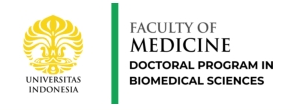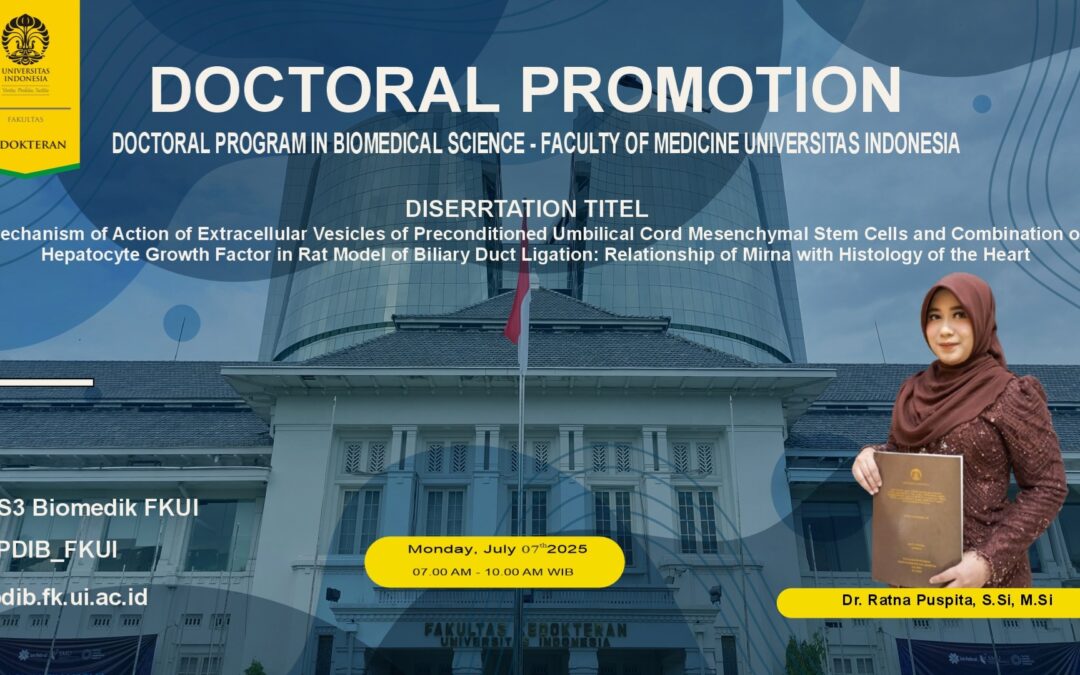Jakarta, June 7, 2025. Bile duct disorders in infants are a serious condition that can cause severe liver damage and even liver failure if not treated properly. The latest research by Ratna Puspita presents a breakthrough through stem cell exosome therapy. Exosomes are small, nanometer-sized vesicles released by mesenchymal stem cells taken from umbilical cord tissue (Wharton’s jelly), which are then preconditioned with patient serum to work optimally according to the patient’s individual condition. Ratna Puspita’s research is funded by DIPA Universitas Indonesia through the International Indexed Publication (PUTI) Q2 – Matching Fund scheme. In addition, Ratna Puspita’s doctoral education funding was obtained from the Indonesian Education Scholarship with support from the Center for Higher Education Financing and Assessment Services and the Education Fund Management Institute (LPDP). Ratna Puspita’s research is the result of close collaboration between the Department of Histology, Faculty of Medicine, University of Indonesia (FKUI) and the Division of Pediatric Surgery, Department of Surgery, FKUI, Cipto Mangunkusumo Hospital (RSCM). This multidisciplinary collaboration combines expertise from pediatric surgery and biomedical sciences to study exosome therapy in bile duct disorders in experimental animals. The experimental animals in the form of mice injected with exosomes and/or a combination of hepatocyte growth factors (HGF) were carried out directly by dr. Wulan Ayudyasari, Sp.B, Subsp. Anak, a pediatric surgeon who is competent in her field.
Ratna Puspita’s research is a continuation of a series of previous studies that focused more on fundamental aspects, namely biomedical science to reveal the mechanism of action of exosomes at the molecular level, especially the role of miRNA in therapy using mesenchymal stem cell exosomes derived from human umbilical cords. The exosomes were first conditioned with serum from patients with bile duct disorders, so that it is expected to provide an overview of the biological mechanisms underlying the effectiveness of exosome therapy. Recognition of this deep scientific basis is important to emphasize that research is not just a clinical application, but upholds the principles of basic research to find more targeted and personalized therapeutic solutions.
“The study was conducted on liver samples from rat models that underwent bile duct ligation to mimic the conditions of bile duct disorders in humans. This preconditioned exosome therapy successfully showed improvements in liver tissue, in the form of increased shape and function of damaged liver cells. This therapy was also tested together with hepatocyte growth factor (HGF) which showed a liver regeneration effect although the results were not better than giving preconditioned exosomes without HGF. Various research methods were used in this study, ranging from electron microscopy, molecular analysis of miRNA, to physicochemical characterization of exosomes as a comprehensive picture of the mechanism of action of preconditioned exosome therapy compared to naive exosomes. Naive exosomes are exosomes obtained from stem cell cultures without modification of the culture media.” said Ratna Puspita. Why is this study important? “Bile duct disorders are one of the main causes of liver damage in infants who often require liver transplants, a complex procedure with limited access. Until now, effective and safe therapies are needed that can improve liver function without having to go through risky invasive procedures. This preconditioned exosome therapy is a new hope that offers a personalized and innovative approach to repairing liver tissue naturally before patients can undergo liver transplants.” Added Ratna Puspita.
Key Findings by Ratna Puspita:
• Exosome characterization: Exosomes produced from umbilical cord stem cells, both naive and preconditioned using patient serum, were proven to be stable, pure, and had a specific molecular profile that supported the effectiveness of therapy.
• Rat model of bile duct obstruction: Administration of preconditioned exosomes to rats with bile duct obstruction showed improved liver morphology with decreased tissue damage and increased liver cell regeneration.
• HGF growth factor support: The combination of preconditioned exosome therapy and HGF strengthened the liver regeneration process as seen from histological results and increased liver function biomarkers.
• Comprehensive analysis methods: This study includes physical characterization of exosomes, miRNA profiles that regulate gene expression, and evaluation of liver tissue using microscopic and molecular biochemical techniques.
Ratna Puspita said that this study presents novelty through the use of preconditioned exosome therapy that utilizes patient serum to increase the effectiveness and personalization of therapy. This approach is an innovation that has not been widely applied before in infant bile duct disorders and provides an in-depth molecular understanding of the mechanism of liver regeneration through exosomes. In addition, the integration of hepatocyte growth factors with exosome therapy opens up a new paradigm in the development of more effective and safe regenerative therapies.
“From the results of our study, it turns out that preconditioned exosome therapy does not provide much better improvements compared to naive exosomes. Likewise, the addition of hepatocyte growth factors (HGF), which although it provides a regenerative effect, does not show a statistically significant difference. Therefore, we recommend that further research focus on optimizing exosome therapy itself, in order to find an approach that is truly effective and provides more real clinical benefits for infants with bile duct disorders,” explained Ratna Puspita.
Ratna Puspita said that although the initial results were very promising, further research was needed with larger samples and in-depth safety and effectiveness studies. These findings pave the way for the development of personalized exosome-based regenerative therapies with the potential to improve liver cell quality before liver transplantation, thereby improving the quality of life of infants with bile duct disorders.

